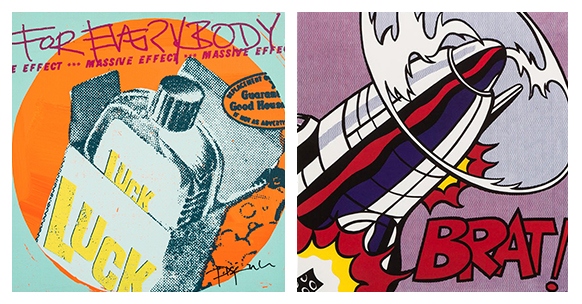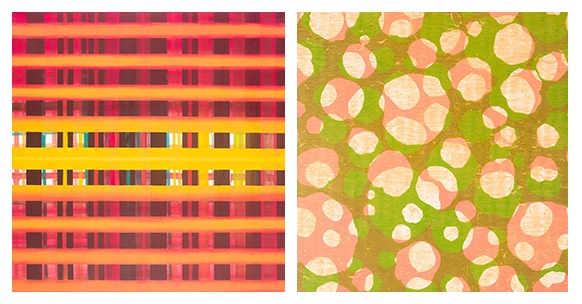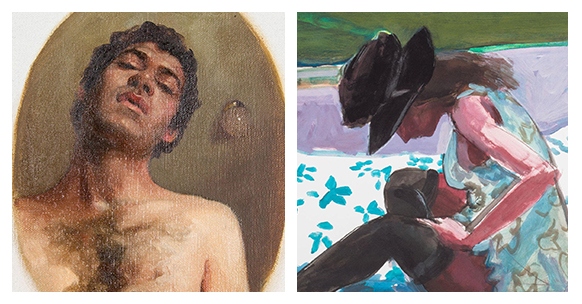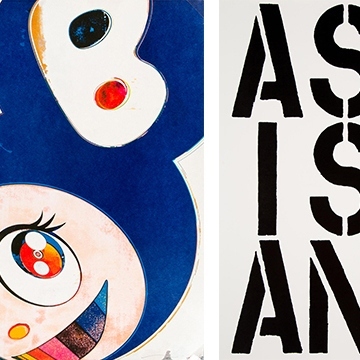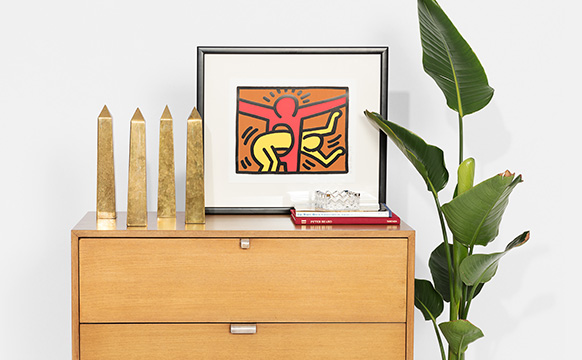
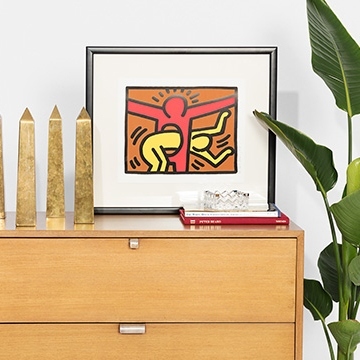
How to Tell a Print from a Painting
If you enjoy perusing art museums in your free time, you’ll know that all of your basic questions about a work can be answered by its corresponding plaque. At a museum or gallery, finding out a piece’s title, artist, date of creation and medium is easy. At a second-hand shop, yard sale or flea market, however, you’ll be hard-pressed to get a definitive answer about anything. And for the budding collector, distinguishing a print from a painting can be difficult and daunting. If you don’t know the difference, how do you really know what you’re investing in? To demystify this art quandary, we asked our Merchandising Manager for Art & Home, Christina Capela, to give us a crash course on how to identify and authenticate prints and paintings. Read on to learn how to school your fellow collectors on the ins and outs of fine art.
Joerg Doering, Untitled (Luck), acrylic on canvas, $5,750; Roy Lichtenstein, As I Opened Fire (Triptych), offset lithograph print, $1,100
Let’s start with the basics. How do you define a painting versus a print?
CC: In broad terms, painting is characterized as the application of pigments to a surface or support. Acrylic, gouache, tempera, watercolor and oil paint are common media. The support may be canvas, paper, metal, et cetera.
A print is a generic term for something that is made in a reproducible format, but a fine art print is made specifically for the chosen medium. Fine art prints are original works of art in their own right. They are not simply copies of an original.
The most basic printmaking concept is the matrix and transfer process. A matrix is the stone, block, plate, screen or stencil that is printed or transferred onto another surface. The printing matrix allows for multiples or copies of the same image to be printed. Artists and publishers typically sign, number and document prints so only a specific number of copies of an image can be made.
Miquel Gelabert, Landscape, oil on canvas, $2,500; Eve Stockton, Untitled, monotype print, $925
Digital means can be also used to develop a matrix, or the digital output can be the end product. Blue chip artists and contemporary photographers produce inkjet prints that fetch high prices at auction. While some may consider digital processes to be less “worthy” than traditional means, this isn’t necessarily the case.
There are numerous types of prints, but we handle lithographs and screenprints for the most part. Lithographs are created by drawing on a prepared stone or plate, applying gum arabic to the surface and then washing the substance away with a solvent, which leaves a stencil. Ink is applied to the stone, paper is placed over the image and is then run through a press to make the print. Screenprinting, on the other hand, is a process in which ink is forced through the openings of a fine mesh stencil-mounted screen.
Jenna Gribbon, Vignette Effect, oil on linen, $4,800; Kim Frohsin, Untitled, digital print, $1,500
Now that we know the difference, how can the average person distinguish one from the other?
CC: Examine both prints and paintings in a clean, well-lit space and note any obvious damage or defect. Then identify the support. Is the support canvas, board, panel, or paper? Flip the work over and check the reverse for any labels and annotations.
Next, view the work using several different angles of light. If you’re unsure of the medium, the texture of the surface should be a good indicator. Brushstrokes, thick impasto and built-up areas of pigment are consistent with paintings. Examine the surface for evidence of a varnish layer, then check for any discoloration, cracks or areas of opacity.
Use a magnifying glass to inspect the surface. Prints will generally have a flatter appearance. If you see small dots, patterns of dots, pixels or screen patterns, the work is a print.
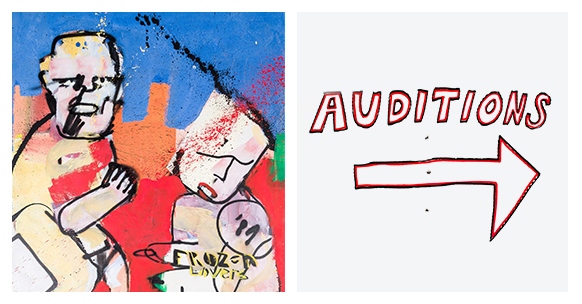
Herman Brood, Frozen Lovers, acrylic on canvas, $4,800; Mike Kelley, Street Sign, screenprint on panel, $4,475
What’s the process for authenticating paintings and prints?
CC: In order to authenticate a work of art, it’s important to accurately identify it. Who is the artist? Is the work signed? Dated? Numbered? Are there any gallery labels, stamps or inscriptions? Is there any accompanying documentation? Is the style and subject matter consistent with the other examples from the artist’s oeuvre?
If the quality and execution of the work look ‘off’ or less than what I might expect, I consider this a red flag. At this point, I’ll begin to consult reference materials and find “comparables,” or works with characteristics that are similar to the piece I’m working with.
For prints, dimensions are an important factor since each impression should be pulled from the same matrix. I’ll also check the numbering, research how many editions were made and look for watermarks or blind stamps. A blindstamp is an embossed seal impressed onto a print as a distinguishing mark by the artist, publisher, or printer. I can use this information to verify that a print was printed by a specific printer or studio.
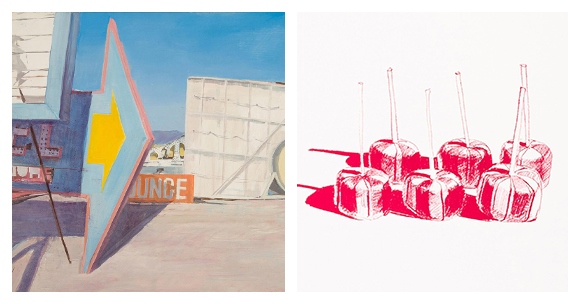
Adam Cvijanovic, Royal Nevada, oil on panel, $7,500; Wayne Thiebaud, Suckers, State II, lithograph, $9,500


